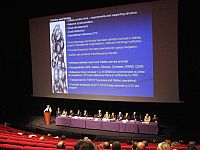 |  By David Powell Special to SPACE.com posted: 16 October 2007 06:46 am ET |
It took 300 years of experiment and calculation to pin down the speed at which light travels in a vacuum: an impressive 186,282 miles per second.
Light will travel slightly slower than this through air, and some wild experiments have actually slowed light to a crawl and seemingly made it go backward, but at the scales encountered in our everyday lives, light is so fast that we perceive our surroundings in real time.
Look up into the night sky and this illusion begins to falter.
"Because light takes time to get here from there, the farther away 'there' is the further in the past light left there and so we see all objects at some time in the past," explains Floyd Stecker of NASA's Goddard Space Flight Center in Greenbelt, Maryland.
Light-years
We see the relatively close moon as it was 1.2 seconds ago and the more distant sun as it was about 8 minutes ago. These measurements—1.2 light-seconds and 8 light-minutes—can be thought to describe both time and distance.
The distance to more remote objects such as other stars is so great it is measured in light-years—the distance light will travel in a year, or about 6 trillion miles (10 trillion kilometers).. Even the nearest star system, Proxima Centauri, lies more than four light-years away, so it appears to us on Earth as it was just over four years ago when the light began its journey.
In this way, light's finite speed gives us a valuable view into the past, and as we strain our gaze deeper into the universe we look further back in time.
"In the case of distant galaxies, we see them as they were billions of years ago when the universe was relatively young," Stecker said.
Out of sight
Some galaxies are so remote that their light hasn't had sufficient time to reach us yet, despite about 13.7 billion years of travel. There could also be more distant objects that will forever remain unknown to us.
"Because the universe is expanding and the expansion appears to be accelerating, there may be distant galaxies which if we can't see them now because their light has not had time to reach us, we will never see," Stecker said.
So we can never see the universe as it is, only as it was at various stages of its development.
To interact with remote parts of the universe—to see them as they are now—would require some exotic means of travel, such as to travel faster than light which, according to Einstein's special theory of relativity, is impossible as it would require an infinite amount of energy.
"The equations of special relativity imply that nothing can go faster then the speed of light in empty space. Therefore, if super-luminal speeds are possible in empty space, they violate the principle of special relativity," Stecker told SPACE.com.
Offbeat theories
There are ways to travel faster than light that do not violate special relativity, but these either outpace light in a transparent medium such as water or do not involve the transmission of information.
To break light speed in space and gain the same easy interaction with the universe that we experience everyday on Earth is a task considered practically impossible even when offbeat theories are considered.
"There are some postulated but unproven theoretical models, inspired by the motivation to unite the quantum theory with the general theory of relativity, which violate special relativity," Stecker said.
These theories involve accelerating particles with mass to super-luminal speeds using ultra high energies. It may also be possible to take a shortcut to distant parts of the universe through a tunnel in space-time known as a wormhole.
"If stable wormholes can exist in space-time and if we can survive traveling through them, then they could provide shortcuts as in the sci-fi movies," Stecker said.


















